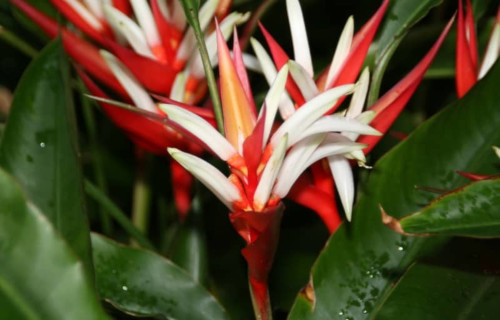
CCL: http://bit.ly/2zBWbKi
We sincerely hope that you enjoy this article about 4 Stunning South American Woody Shrubs. Obviously, these 4 represent only the barest percentage of similar plants to be found in this part of the world. But, we hope that these selections will give you at least a small idea of the incredible bounty Nature has blessed this area of the world with.
Christmas Cactus
Christmas Cactus Facts
- Our first choice for inclusion in this list of 4 Stunning South American Woody Shrubs is the breathtaking, and surprising, Christmas Cactus.
- Firstly, perhaps the most noteworthy attribute of the fabulous cactus remains one that might surprise most people. Secondly, that surprising attribute is the fact that this beautiful and distinctive plant typically actually blooms during the Christmas season.
- However, the distinctiveness of this particular plant does not end there. That’s because yet another interesting fact remains concerning this remarkable species. As a result of evolving in its particular habitat, this particular variety of cactus grows on trees or rock outcroppings.
- Furthermore, due to its tendency to bloom during the season of Christmas, the genus has spread far beyond its endemic range. Rather understandably, it became quite popular as an ornamental plant. This fact holds especially true of its presence in gardens and as a houseplant.
- Finally, only 6 known related species comprise this somewhat small but beautiful genus. Additionally, not to mention amazingly, all of them inhabit the same highly restricted endemic habitat range. Sadly, its natural habitat currently remains quite vulnerable to climate change.
Christmas Cactus Physical Description
First of all, in its natural habitat, the magnificent Christmas Cactus most commonly takes the form of a rather large shrub. As a result, the thick, woody base of each plant attains an average height of about 4 ft (1.2 m). The wonderful plant also typically grows quite wide in relation to its height.
The stems typically resemble leaf-like pads and display a beautiful dark green color. Much as other cacti, the plant does not produce any leaves. Yet, the numerous flowers appear in large numbers and a truly wide range of colors. These colors include yellow, white, pink, red, orange, and even purple.
Furthermore, these beautiful blooms only develop at either the tips or joints of the many stems. In addition, the small, delicate fruit also has a rather surprising fleshy consistency. Finally, the tiny black seeds of this amazing species remain extremely small, measuring less than 1 mm in size.
- Kingdom: Plantae
- Phylum: Angiosperm
- Class: Eudicots
- Order: Caryophyllales
- Family: Cactaceae
- Genus: Schlumbergera
Christmas Cactus Distribution, Habitat, and Ecology
First of all, the spectacular Christmas Cactus occurs naturally in only one particular region of the world. That restricted range consists of the coastal mountains of southeastern Brazil, in South America. This specifically includes the states of Rio de Janeiro, Sao Paulo, Minas Gerais, and Espirito Santo.
In addition, even in this highly restricted region, the fascinating species exhibits extreme selectivity in its choice of habitat. That’s because, in this location the plant appears almost exclusively on either trees or rocks. In addition, these areas must also possess both shade and high humidity.
At the same time, the Christmas Cactus only appears to grow at a select range of altitude. This covers elevations ranging between 2,300- 9,120 ft (700 – 2,780 m). But, it has an evolutionary reason for this selectivity. Its unique location provides it with warm, moist air, forced upwards to its location.
The amazing species also developed a unique dependency upon local bird species. Its tiny seeds do not release spontaneously when the fruit ripens, like many plants. Therefore, it generally relies upon the birds to spread them after consuming the fruit. However, the plants occasionally reproduce via vegetative propagation, as well.
Cycad
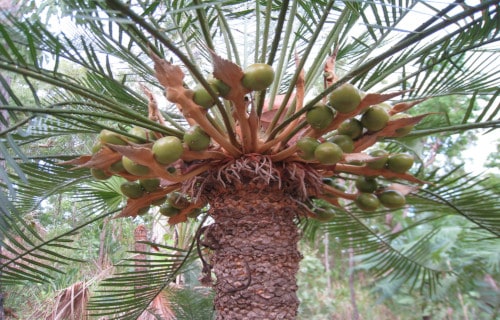
CCL: https://bit.ly/2wLun7D
Cycad Facts
- Next up in this article concerning 4 Stunning South American Woody Shrubs is the truly amazing plant known simply as the Cycad.
- Perhaps most notably of all, the Cycad forms a Family of seed plants whose origins go all the way back to the Permian Era. More precisely, and quite amazingly, the Cycad appears to have evolved roughly 280 million years ago. Furthermore, although the various varieties bear a physical resemblance to palms, these in reality represent a distinctly different family.
- Further, numerous species related to this fantastic group of plants once remained highly prevalent throughout the world. Currently, however, botanists only recognize a total of 305 species comprising this amazing and quite unique Family. Amazingly, though, the various forms appear to be relatively unchanged by evolution through the ages.
- Additionally, many non-professionals often confuse the many types of Cycad with various palms. This confusion principally occurs due to a surprising superficial resemblance between the two groups. But in reality, the two remain quite different from each other. To a great many researchers, this purely coincidental external resemblance represents an excellent example of convergent evolution.
- Sadly, however, roughly 38% of the members of this remarkable group presently appear on the IUCN Red List of Threatened Species. This regrettable status occurs for a variety of reasons for different species. Habitat loss due to human encroachment on the natural range of the plants plays a pivotal role for many. However, climate change now comprises a key threat to all of them.
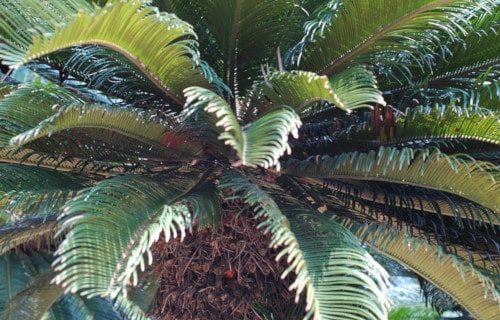
CCL: https://bit.ly/2SXQd0l
Cycad Physical Description
Firstly, given the sheer number of differing plants qualifying as a Cycad, physical differences quite understandably exist. Secondly, what’s surprising is that they are not more different from each other than they are. For one thing, the differing forms comprising the Family develop in a rather wide variety of shapes, sizes, and appearances.
Nevertheless, the different plants all have many things in common, as one would naturally expect to be the case. Physical size, however, does not rank among the many shared physical traits. That’s because some of them measure no more than 1 in (2.5 cm) in height. Meanwhile, other varieties of Cycad reach heights of more than 10 ft (3 m).
But, one of the things that all of them do share is the structure of the trunk. First, that holds true because of the fact that all known types possess a relatively thick trunk. Secondly, this trunk does not branch at all. The structure does, however, most typically develop a crown of relatively large pinnate leaves. These always stay evergreen in nature and grow directly from the trunk itself.
- Kingdom: Plantae
- Phylum: Cycadophyta
- Class: Cycadopsida
- Order: Cycadales
- Family: Cycadaceae
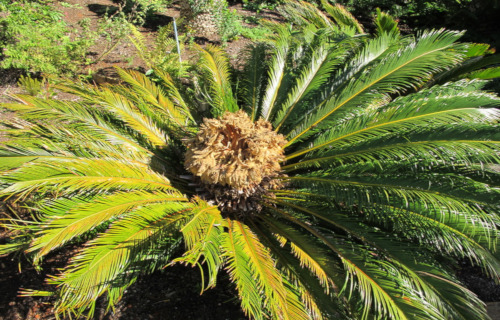
CCL: https://bit.ly/2VhXr0p
Cycad Distribution, Habitat, and Ecology
Since the term Cycad applies to an entire Family of vascular plants, the native range understandably remains quite extensive. In fact, the greatest concentration of the numerous types appears in Central America and South America. Yet members of the Family also appear in such regions as Mexico and the United States, in North America, as well as China and Madagascar, among many others.
In all parts of the world these plants appear in, though, they show a decided preference for certain climates. That’s because the only regions this Family appears in are tropical and subtropical areas. Furthermore, the majority of varieties thrive in hot, warm conditions. This remains especially true of regions consisting largely of tropical rainforests. That’s because a total of 65 species occur in tropical portions of Africa.
However, the Cycad never ceases to amaze us. That’s because it displays remarkable adaptability in some respects. That’s because some varieties appear only in desert environments. Furthermore, a few species appear to be adaptable enough to thrive in both of these climates. But it does not stop there. This holds true due to the fact that a few species even manage to grow on rocky outcroppings and in swamps.
Also, all species within this incredible Family have a dioecious nature. In addition, in terms of its reproductive strategy, all members of the group represent gymnopserms. Most varieties achieve pollination via the activities of various beetles. In fact, quite often a specific species of beetle pollinates only one particular form of Cycad. Finally, all known varieties of this plant typically grow very slowly. They also tend to be very long-lived. Some species live for as long as 1,000 years.
Christmas Heliconia

CCL: http://bit.ly/2zBWbKi
Christmas Heliconia Facts
- The third breathtaking species we selected for inclusion in this compendium of 4 Stunning South American Plants is the Christmas Heliconia.
- First of all, the quite gorgeous plant derives its name from its appearance and time of blooming. This amazing fact holds true due to one of those coincidences that sometimes occur in Nature. That’s because this unique botanical beauty typically blooms around the Christmas season.
- In addition, the timing of its blooming combines with its own rather beautiful patterns of color. This consists of vividly red and white flowers that combine to generate a truly marvelous characteristic. Quite understandably, these two factors directly led to its distinctive common name.
- Rather unfortunately, however, the IUCN also recently listed the Christmas Heliconia on its Red List of Threatened Species. There, this plant classifies as Vulnerable. This unfortunate status occurs due to the fact that most of its natural habitat has now been converted by humans to farmland.
- Furthermore, the species now appears to also be quite rare in the wild in its endemic range. However, it also remains extremely popular in many portions of the world as a garden or ornamental plant. Therefore, for the moment, the future of the species seems fairly bright.
- We sincerely hope that its popularity serves to prevent its complete extinction as a species. However, fears also exist that the species will soon become extinct in its natural environment. There, it faces several dangers. But the primary threats it faces there include habitat loss and climate change .
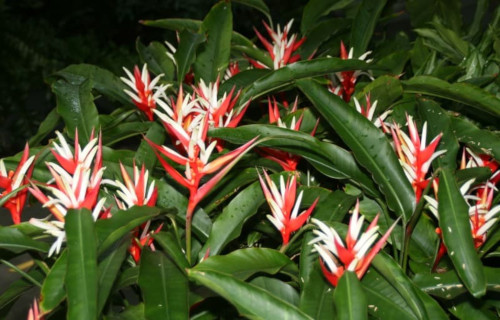
CCL: http://bit.ly/2zBWbKi
Christmas Heliconia Physical Description
Perhaps the most notable fact about the supremely gorgeous Christmas Heliconia remains the fact that it evolved as a tropical species. Furthermore, the plant evolved a surprising trait in its hardiness. Despite its seemingly sturdy construction, however, botanists classify the species as a delicate perennial.
Firstly, the plants themselves typically grow relatively large, at least compared to related species. That’s because individual specimens typically attain a height of between 6-8 ft (1.8-2.4 m). Secondly, though, the foliage it develops appears as evergreen, and the leaves typically have a rather leathery texture.
Further, the most commonly produced color combination remains the memorable primarily red and white. Not surprisingly, this pattern represents the one for which it remains best known, even today. However, other colors also appear occasionally. These variations most often include yellow and orange.
The natural wonder of Nature also distinguishes itself in yet another remarkable manner. This holds true due to the fact that in the wild, the Christmas Heliconia reproduces via seeds alone. Yet, in cultivation, the amazing Angiosperm also reproduces via root propagation, increasing its versatility.
- Kingdom: Plantae
- Phylum: Angiosperms
- Class: Monocots
- Order: Zingiberales
- Family: Heliconiceae
- Genus: Heliconia
- Species: H. angusta
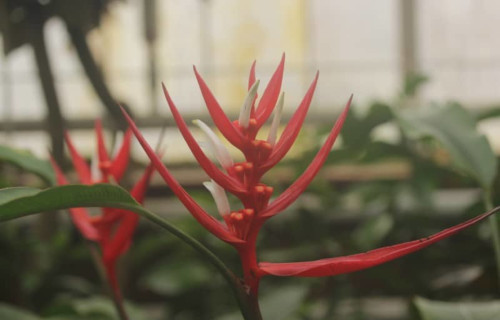
CCL: http://bit.ly/2xLZ0ap
Christmas Heliconia Distribution, Habitat, and Ecology
Not surprisingly, the magnificent Christmas Heliconia evolved as endemic to a decidedly warm and quite lush environment. In fact, this beauty only appears naturally in a rather restricted portion of the world. This fortunate area consists solely of the southeastern portion of the country of Brazil, in South America.
As one might expect, within its native environment, the plant typically inhabits regions of the lush tropical forest. It also bears one trait in common with many closely related species. That’s because this marvelous Angiosperm variety grows best in the primarily warm, moist conditions found there.
Yet, to the astonishment of some, many individual plants often appear to be rather adaptable to highly variable conditions. That’s because most specimens observed also grow well in either full sun or moderate shade. Further, the majority of plants produce the now famous flowers, regardless of the region it grows in.
Finally, this remarkably impressive species also plays an important role in its native habitat. There, the plant quite frequently serves as a shelter for numerous types of bats native to the region, along with several other animals. It also serves as a major food source for many varieties of hummingbirds.
Hummingbird Fuchsia
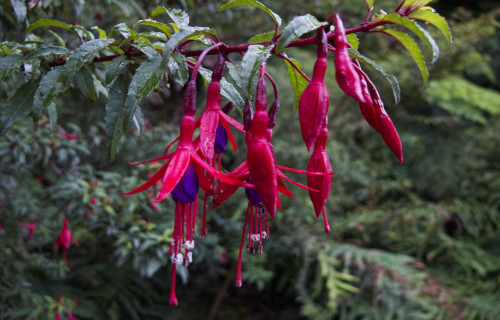
CCL: https://bit.ly/32rniEL
Hummingbird Fuchsia Facts
- The final entry into this compendium of 4 Stunning South American Woody Shrubs, the Hummingbird Fuchsia, appears in that spot only due to random selection.
- First of all, many consider the Hummingbird Fuchsia to be among the most beautiful of all shrubs. Secondly, the sheer size of this plant and its tendency to produce many blooms cause it to stand out from many related plants. These traits have also made it a favorite of many horticulturists.
- In addition, while it evolved as a temperate climate species, it and its cultivars remain relatively resistant to the cold. The species also reproduce easily, and in a somewhat wide variety of ways. That’s because the shrub can reproduce either by seed, in its usual manner, or via cuttings.
- It also remains worth noting that within its endemic range, the Hummingbird Fuchsia serves as a staple food source for many hummingbird species, hence the common name. The species owes this to its tendency to produce large quantities of nectar, and the distinctive shape of its flowers.
- Quite sadly, however, while this beautiful species has not yet been officially classified as endangered by the IUCN, that may soon change. This holds true due to the rather sad fact that large portions of its native habitat continue to be threatened by both climate change and human activities such as deforestation.
Hummingbird Fuchsia Physical Description
While the amazing species appears to many people to be a small tree due to its size, botanists classify the Hummingbird Fuchsia as a shrub. Furthermore, this beautiful species often attains heights of as much as an astounding 11 ft (3.3 m) in ideal climates. In addition, the widely branching shrub further reaches a maximum width of as much as 10 ft (3 m) at times.
Also, as remains quite common with most shrubs, this species produces a great number of mainly horizontal, rather than vertical, branches. But its awesomeness does not end there. The gorgeous deciduous plant also produces numerous hermaphroditic flowers. These large groups of blooms achieve pollination through the activities of a wide variety of insects.
Additionally, the species remains renowned for the startling beauty of the blooms. These features possess a long tubular shape and may be either pink, red, lavender, or white in color. Small, yet numerous, reddish purple fruits follow the flowers. The lance-shaped foliage also displays a unique trait. While green on top, the underside displays a reddish color.
- Kingdom: Plantae
- Phlyum : Angiosperms
- Class: Eudicots
- Order: Myrtales
- Family: Onagraceae
- Genus: Fuchsia
- Species: F. magellanica
Hummingbird Fuchsia Distribution, Habitat, and Ecology
Quite unfortunately for its admirers, the magnificent Hummingbird Fuchsia grows naturally only in a restricted region of the southern cone of South America. More precisely, this region entails limited portions of the countries of Chile and Argentina. But even there it only grows in areas of a temperate climate.
However, the stunning Angiosperm has now become naturalized in many other regions throughout the world. These areas include portions of Australia and the United States, in North America. But even in its native range, it remains selective, primarily appearing in either forest clearings or margins.
It also display great adaptability to differing climates. This holds true because the plant appears equally in both evergreen and deciduous forests. The species grow best in regions of partial shade and very moist soil. In addition, blooming typically occurs during early to late summer, depending upon specific location.
Finally, the magnificent shrub typically matures comparatively quickly. Furthermore, it also spreads rapidly under ideal conditions. While its popularity as an ornamental plant affords it some protection from extinction, it faces a strong threat in the wild. This consists of an insect pest called the gall mite.
4 Stunning South American Woody Shrubs
We truly hope that you have enjoyed reading this article about 4 Stunning South American Woody Shrubs. The sheer variety and unquestioned beauty of such species leave us wanting more. We hope that you fell the same way. However, many of these marvelous species now find themselves facing great peril. Many factors now threaten their continued existence. It is up to each of us to do all that we can to preserve for our posterity.
Check out our other articles on Earth’s Many Astounding Beetles, Rare North American Flowering Plants, Spectacular Dolphins Throughout Our World, Earth’s Geothermal Marvels
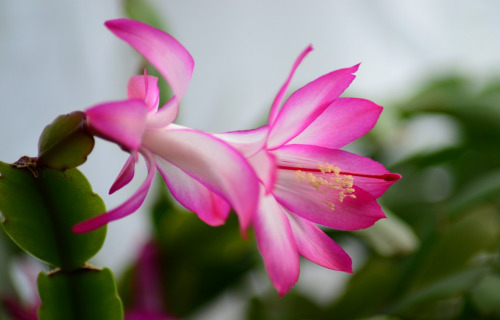
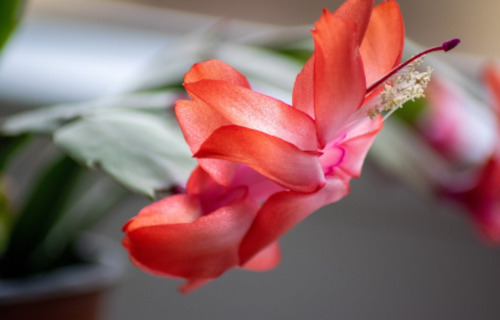
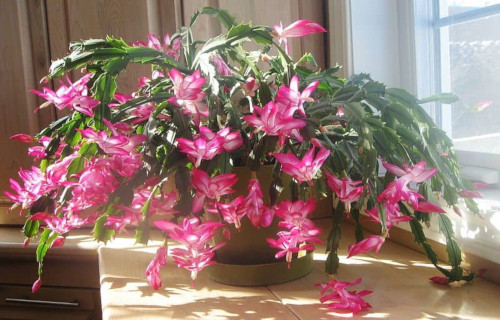











Leave a Reply